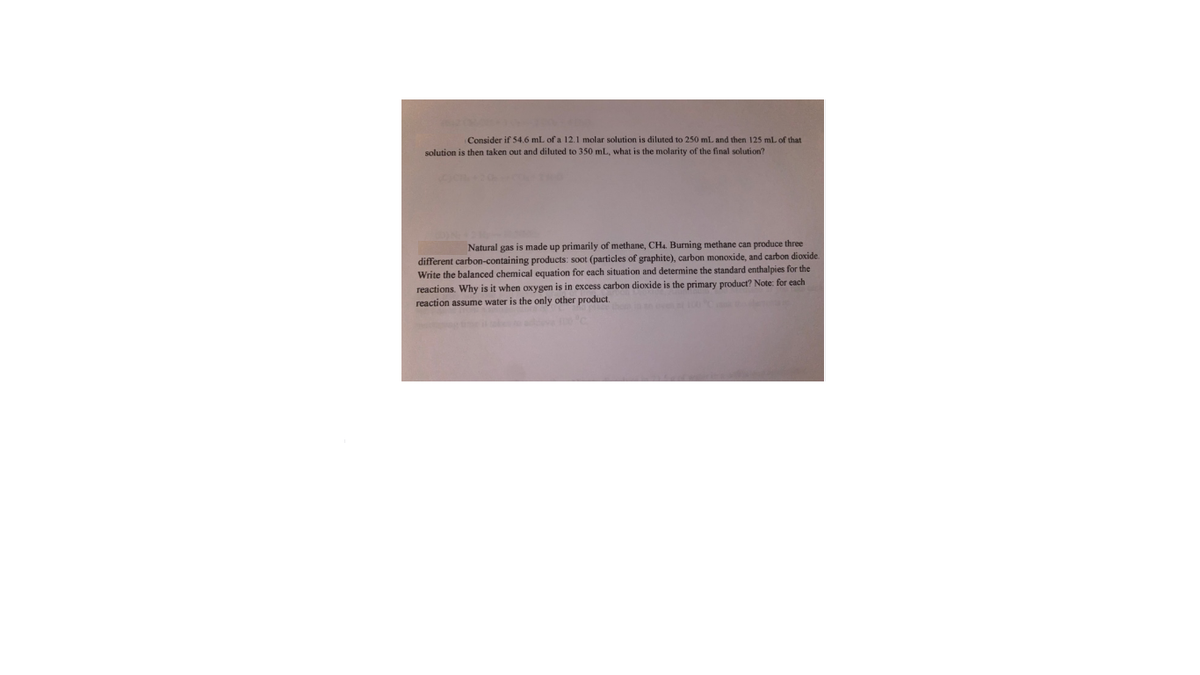Consider if 54.6 mL of a 12.1 molar solution is diluted to 250 mL and then 125 mL of that solution is then taken out and diluted to 350 mL, what is the molarity of the final solution? Natural gas is made up primarily of methane, CH4. Burning methane can produce three different carbon-containing products: soot (particles of graphite), carbon monoxide, and carbon dioxide. Write the balanced chemical equation for each situation and determine the standard enthalpies for the reactions. Why is it when oxygen is in excess carbon dioxide is the primary product? Note: for each reaction assume water is the only other product.
Consider if 54.6 mL of a 12.1 molar solution is diluted to 250 mL and then 125 mL of that solution is then taken out and diluted to 350 mL, what is the molarity of the final solution? Natural gas is made up primarily of methane, CH4. Burning methane can produce three different carbon-containing products: soot (particles of graphite), carbon monoxide, and carbon dioxide. Write the balanced chemical equation for each situation and determine the standard enthalpies for the reactions. Why is it when oxygen is in excess carbon dioxide is the primary product? Note: for each reaction assume water is the only other product.
Chemistry
10th Edition
ISBN:9781305957404
Author:Steven S. Zumdahl, Susan A. Zumdahl, Donald J. DeCoste
Publisher:Steven S. Zumdahl, Susan A. Zumdahl, Donald J. DeCoste
Chapter4: Types Of Chemical Reactions And Solution Stoichiometry
Section: Chapter Questions
Problem 47E
Related questions
Question
Question is attached

Transcribed Image Text:Consider if 54.6 mL of a 12.1 molar solution is diluted to 250 mL and then 125 mL of that
solution is then taken out and diluted to 350 mL, what is the molarity of the final solution?
Natural gas is made up primarily of methane, CH4. Burning methane can produce three
different carbon-containing products: soot (particles of graphite), carbon monoxide, and carbon dioxide.
Write the balanced chemical equation for each situation and determine the standard enthalpies for the
reactions. Why is it when oxygen is in excess carbon dioxide is the primary product? Note: for each
reaction assume water is the only other product.
Expert Solution
This question has been solved!
Explore an expertly crafted, step-by-step solution for a thorough understanding of key concepts.
This is a popular solution!
Trending now
This is a popular solution!
Step by step
Solved in 6 steps

Knowledge Booster
Learn more about
Need a deep-dive on the concept behind this application? Look no further. Learn more about this topic, chemistry and related others by exploring similar questions and additional content below.Recommended textbooks for you

Chemistry
Chemistry
ISBN:
9781305957404
Author:
Steven S. Zumdahl, Susan A. Zumdahl, Donald J. DeCoste
Publisher:
Cengage Learning

Chemistry: An Atoms First Approach
Chemistry
ISBN:
9781305079243
Author:
Steven S. Zumdahl, Susan A. Zumdahl
Publisher:
Cengage Learning


Chemistry
Chemistry
ISBN:
9781305957404
Author:
Steven S. Zumdahl, Susan A. Zumdahl, Donald J. DeCoste
Publisher:
Cengage Learning

Chemistry: An Atoms First Approach
Chemistry
ISBN:
9781305079243
Author:
Steven S. Zumdahl, Susan A. Zumdahl
Publisher:
Cengage Learning


Chemistry: Principles and Practice
Chemistry
ISBN:
9780534420123
Author:
Daniel L. Reger, Scott R. Goode, David W. Ball, Edward Mercer
Publisher:
Cengage Learning


Introductory Chemistry: A Foundation
Chemistry
ISBN:
9781337399425
Author:
Steven S. Zumdahl, Donald J. DeCoste
Publisher:
Cengage Learning